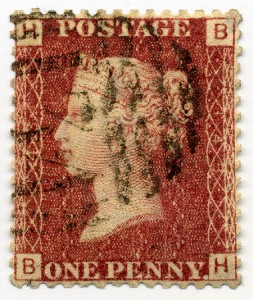Airmail stamps – for payment of airmail service. The term “airmail” or an equivalent is usually printed on special airmail stamps. Airmail stamps typically depict images of airplanes and/or famous pilots and were used when airmail was a special type of mail delivery separate from mail delivered by train, ship or automobile. Aside from mail with local destinations, today almost all other mail is transported by aircraft and thus airmail is now the standard method of delivery.
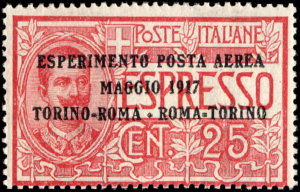 First official airmail stamp, issued by Italy Postal Service in May 1917.
First official airmail stamp, issued by Italy Postal Service in May 1917.
Postage Stamp Booklet – is a booklet made up of one or more small panes of postage stamps in a cardboard cover. Booklets are often made from sheets especially printed for this purpose, with a narrow selvage at one side of the booklet pane for binding. From the cutting, the panes are usually imperforate on the edges of the booklet. Smaller and easier to handle than a whole sheet of stamps, in many countries booklets have become a favored way to purchase stamps.
Carrier’s stamp – is a type of postage stamp used by private mail carriers to deliver mail directly to an addressee from the post office. When the postal service was first organized and the delivery of mail was only from one post office to another post office and not directly to the addressee. This created the need for private mail carriers. In the United States, this specialized category of stamps existed mainly from 1842 to 1860.
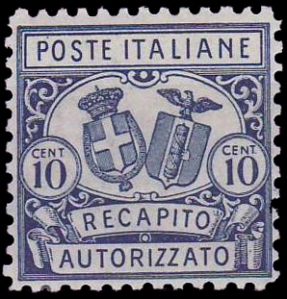 First carrier stamp of Italy, 1928.
First carrier stamp of Italy, 1928.
Certified Stamp – (registered mail) is a mail service offered by postal services in many countries, which allows the sender proof of mailing via a mailing receipt and, upon request electronic verification that an article was delivered or that a delivery attempt was made.
Coil Stamp – is a type of postage stamp sold in strips one stamp wide. The name derives from the usual handling of long strips, which is to coil them into rolls, in a manner reminiscent of adhesive tape rolls. A large percentage of modern stamps are sold in coil form, because they are more amenable to mechanized handling in large quantities than either sheet stamps or booklet stamps.
Commemorative stamp – is a postage stamp, often issued on a significant date such as an anniversary, to honor or commemorate a place, event, person, or object. The subject of the commemorative stamp is usually spelled out in print, unlike definitive stamps which normally depict the subject along with the denomination and country name only.
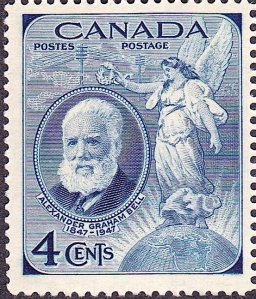 Alexander Graham Bell commemorative issue of 1947.
Alexander Graham Bell commemorative issue of 1947.
A postage meter or franking machine – is a mechanical device used to create and apply physical evidence of postage (or franking) to mailed matter. Postage meters are regulated by a country’s postal authority. A postage meter imprints an amount of postage, functioning as a postage stamp, a cancellation and a dated postmark all in one. The meter stamp serves as proof of payment and eliminates the need for adhesive stamps.
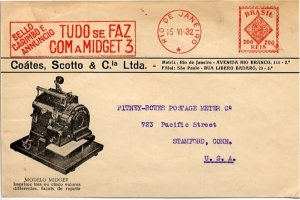 An early machine pictured on a 1932 envelope from Brazil addressed to Pitney Bowes.
An early machine pictured on a 1932 envelope from Brazil addressed to Pitney Bowes.
Definitive stamp – is a postage stamp that is part of the regular issue of a country’s stamps, available for sale by the post office for an extended period of time and designed to serve the everyday postal needs of the country. The term is used in contrast to a “provisional stamp”, one that is issued for a temporary period until regular stamps are available, or a “commemorative stamp”, a stamp “issued to honor a person or mark a special event” available only for a limited time. Commonly, a definitive issue or series includes stamps in a range of denominations sufficient to cover current postal rates.
Express mail – is an accelerated mail delivery service for which the customer pays a surcharge and receives faster delivery. Express mail is a service for domestic and international mail and is in most countries governed by a country’s own postal administration.
Local post – is a mail service that operates only within a limited geographical area, typically a city or a single transportation route. Historically, some local posts have been operated by governments, while others, known as private local posts have been for-profit companies. Today, many stamp collectors operate hobbyists’ local posts, issuing their own postal “stamps” for other collectors but rarely carrying any mail.
Military stamp – is a postage stamp used by a military organisation, in time of war, or while ensuring a peace keeping operation. Often the letters will be transported by the army itself until they reach the country of destination. These stamps were widely used during World War II by soldiers wishing to send mail home to their families. The usage of these stamps has been somewhat phased out by the appearance of electronic means of communication. Some army issues include:
- China Expeditionary Forces (1900-1921)
- Indian Expeditionary Forces (1914-1922)
- British occupation of Mafia Island (1915-1916)
- British Field Office in Salonica (1916)
- Nyasaland Field Force (1916)
- Egyptian Expeditionary Force (1918)
- Indian Expeditionary Force D (1919)
- British Forces in Egypt (1932-1939)
- Middle East Forces (1942-1947)
- East Africa Forces (1943-1946)
- Indian National Army (World War II)
- Indian Custodian Forces in Korea (1953)
- International Commission in Indo-China (1954-1968)
- Indian UN Force in Congo (1962)
- Indian UN Force in Gaza (1965)
Minisheet — a commemorative issue smaller than a regular full sheet of stamps, but with more than one stamp. Minisheets often contain a number of different stamps, and often having a decorative border.
Newspaper stamp – is a special type of postage stamp used to pay the cost of mailing newspapers and other periodicals. Although many types were issued in the 19th century, typically representing rates reduced from regular mail, they generally fell out of use in the mid-20th century, as mail services began to arrange bulk handling directly with publishers.
Official mail – is mail sent from, or by, an authorized department of government, governmental agency or international organization and normally has some indication that it is official; a certifying cachet, return address or other means of identity, indicating its user.
Non-denominated postage – is postage intended to meet a certain postage rate that retains full validity for that intended postage rate even after the rate is increased. It does not show a monetary value, or denomination, on the face.
An overprint – is an additional layer of text or graphics added to the face of a postage stamp, banknote or postal stationery after it has been printed. Post offices most often use overprints for internal administrative purposes such as accounting but they are also employed in public mail. The most well-recognized varieties are commemorative overprints which are produced for their public appeal and command significant interest in the field of philately.
Perfin – is a stamp that has had initials or a name perforated across it to discourage theft. The name is a contraction of perforated initials or perforated insignia.
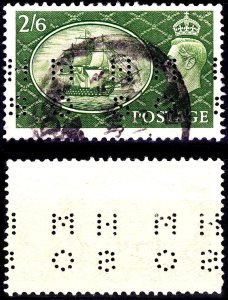 A 1951 perfin stamp of Great Britain showing front (top) and reverse (bottom).
A 1951 perfin stamp of Great Britain showing front (top) and reverse (bottom).
Personalised (or personalized) stamp – is a postage stamp, with an adjoining label on the left, on which, for a fee, an image of the purchaser’s choosing may be placed. The stamps vary from country to country and while some are normal stamps with a personalised label on the left attached by perforations, elsewhere the stamps are more properly regarded as one-piece personalised meter stamps with a colourful design next to the indicia.
Postage due – is the term used for mail sent with insufficient postage. A postage due stamp is a stamp added to an underpaid piece of mail to indicate the extra postage due.
Self-adhesive stamp – is a postage stamp with a pressure-sensitive adhesive that does not require moistening in order to adhere to paper. They are usually issued on a removable backing paper. They were first issued by such tropical climates as Sierra Leone in February 1964 and Tonga in April 1969 in an attempt to avoid the tendency of traditional water-activated stamps to stick together in humid conditions. They also made die cutting into fanciful and unique shapes easier.
Semi-postal stamp or semipostal stamp, also known as a charity stamp, is a postage stamp issued to raise money for a particular purpose (such as a charitable cause) and sold at a premium over the postal value. Typically the stamp shows two denominations separated by a plus sign, but in many cases the only denomination shown is for the postage rate, and the postal customer simply pays the higher price when purchasing the stamps.
Souvenir sheet — a commemorative issue in large format valid for postage often containing a perforated or imperforate stamp as part of its design.
Specimen stamp – is a postage stamp or postal stationery indicium sent to postmasters and postal administrations so that they are able to identify valid stamps and to avoid forgeries. The usual method of invalidating the stamps is either overprinting in ink or perforating the word Specimen across the stamp.
Test stamp – is a label resembling a postage stamp that is used by postal authorities for testing equipment. They generally have the same size and shape as regular stamps, but with a minimal design.
Variable value stamp – is a gummed or self-adhesive postage stamp of a common design, issued by a machine similar to an Automatic Teller Machine, with a value of the user’s choice printed at the time the stamp is dispensed.
War tax stamp – is a type of postage stamp added to an envelope in addition to regular postage. It is similar to a postal tax stamp, but the revenue is used to defray the costs of a war; as with other postal taxes, its use is obligatory for some period of time.
Source: Wikipedia

